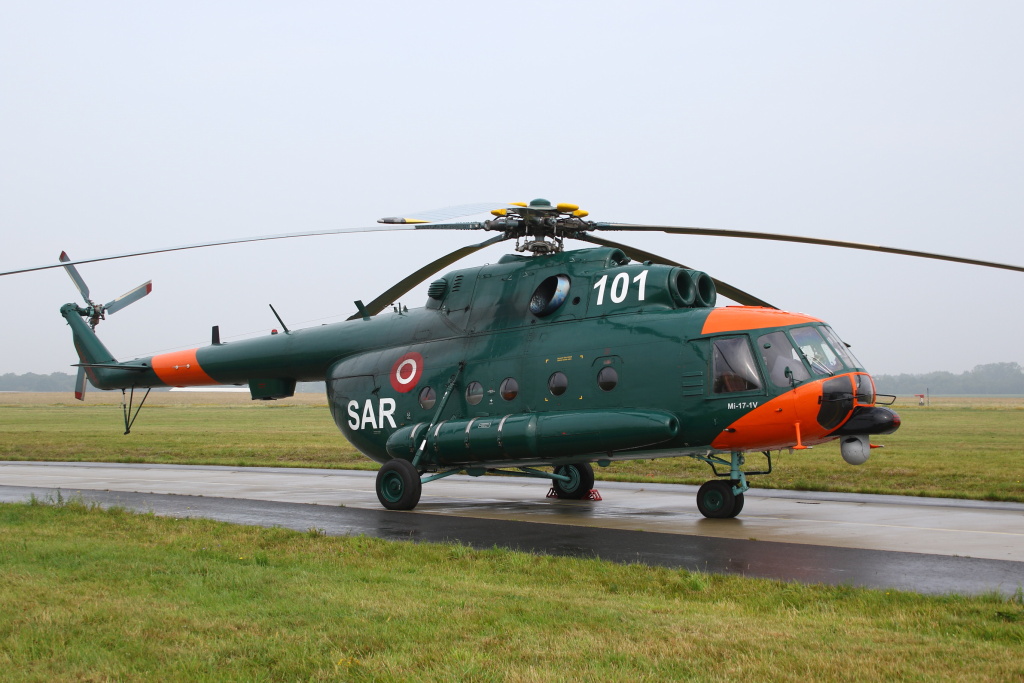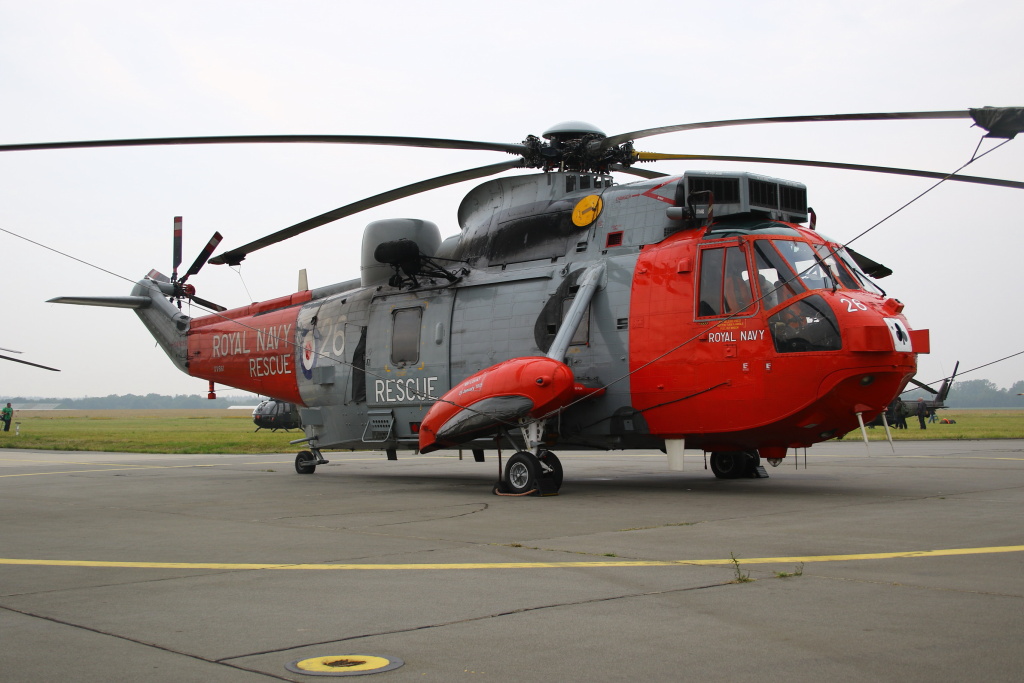|
Ronald de Roij reports on the SAR
meet 2015 at Nordholz NAS
Pictures by the
authors unless stated otherwise
In Europe, active SAR units gather once
a year on the occasion of an International SAR meet, which is organised
on a rotating basis by participating units or nations. A SAR meet
consists of a number of contests allowing the different teams to improve
their skills by learning from other competitors, whether they are
pilots, navigators, flight engineers, medics or divers.
After the 2014 ‘farewell’ meet of Dutch 303 Sq. (the unit disbanded in
2015, handing over SAR duties to a civil contractor) the 7th annual SAR
Meet event was organized Marine Flieger Gruppe 5 (Naval Air Wing 5) at
Naval Air station Nordholz in Northern Germany.
From the 13th to the 17th of August 2015, this event was the first one
organized by MFG 5 after their move from Kiel to Nordholz in 2012.

|
A
Mi-17 flown by the Latvian Air Force's Helikopteru Posms
(Helicopter Squadron).
Helicopters of this small Air Force are rarely seen outside
their home country, making this Mi-17 a welcome sight. |
SAR meet
Search And Rescue (SAR) is a service provided by all member states of
the United Nations and comprises the search for and the provision of aid
to persons, aircraft, ships or other craft which are, or are feared to
be, in distress or imminent danger. How this service has to be performed
is laid down in documents published by the International Civil Aviation
Organisation (ICAO) and the International Maritime Organisation (IMO),
two specialised bodies of the United Nations.
The implementation of those standardised rules and regulations, however,
usually takes place at the national level, hence the existing
differences in organisation, procedures and equipment. It is therefore
of paramount importance for SAR units to become acquainted with the
equipment, capabilities and operating procedures of other SAR providers.
This applies especially for SAR services of neighbouring countries as
they have to be ready and able to work together in case of major
accidents or disasters. That is why international SAR exercises and
meetings are organised on a regular basis.
Participating units:
| |
Unit |
Type |
Country |
| |
40 squadron |
NH-90 NFH |
Belgium |
| |
Verbindungshubschrauberstaffel |
Alouette 3 SA-316B |
Austria |
| |
Latvian air force, helicopter
squadron |
Mi-17-1V |
Latvia |
| |
771 Air Naval Squadron |
Sea King |
United Kingdom |
| |
TrspHubschrRgt 10 |
Bell UH1D |
Germany |
| |
TrspHubschrRgt 30 |
Bell UH1D |
Germany |
| |
3.FlgStff LTGrp Holzdorf |
CH-53 GA |
Germany |
| |
IntHubschrAusbZ Bückeburg |
EC135 |
Germany |
| |
IntHubschrAusbZ Celle |
BO 105 |
Germany |
| |
RK Flugdienst / Appen |
DO-28 |
Germany |
| |
MFG 3 |
P3C Orion |
Germany |
| |
MFG 3 |
DO-228 |
Germany |
| |
MFG 5 |
Sea Lynx Mk88A |
Germany |
| |
MFG 5 |
Sea King Mk41 |
Germany |
| |
MFG 5 |
EC135 |
Germany |
| |
DL Helicopter Technik GmbH |
BK117 |
Germany |

|
During the festivities of the
media and family day, one of the Sea Kings of MFG 5 remained
on standby. Reminding the visitors that the SAR mission is a
24/7 operation. |
MFG-5
MFG 5 has been in the SAR business
since 1958, although it must be said that SAR is not the units sole
task. SAR started out in July 1958 on the Bristol Sycamore. These rather
small machines gave way to the much larger Sikorsky H-34G from April
1963. The unit's current fleet of 21 Westland Sea King Mk.41 took over
from the H-34G's during April 1975.
After the recent move from Kiel to Nordholz, MFG 5 became the operating
organization of all the helicopters of the German Navy. It already
operated twenty-one Westland Sea Kings (to become the 1st flying Staffel)
and the twenty-two Westland Lynxes from MFG 3 (now 3rd flying Staffel of
MFG 5) already stationed at Nordholz) were transferred to MFG 5. The
fixed wing aircraft of the German Navy (P-3C Orion and Dornier 228)
remain with MFG 3.
The Westland Sea King Mk.41 was introduced into service in 1975. The
German Sea King Mk. 41 was the blueprint for all SAR Sea Kings used by
RNoAF, BAF and even the No. 202 Squadron RAF. In 1987 a modernizing
program was started to give the Sea King Mk.41 a limited offensive role.
After more than 40 years of operating the Sea King, the German Navy is
hoping to introduce the its replacement in the form of the NH90 NFH.
Entry into service is planned for 2018, so they can phase out the
Westland Sea King Mk.41 by 2020. There is a need for 18 airframes but a
decision has not been taken, although this was planned for the beginning
of 2015.

|
The two Royal Navy UK Search
and Rescues units, 771 Naval Air Squadron based at RNAS
Culdrose and Gannet SAR Flight based at HMS Gannet, will
finish their SAR duty on 2nd January 2016, ending the SAR
role of the Sea King in the UK. |
The exercise
A typical SAR meet lasts just a few days and is not organized along a
strict set of rules and procedures. During the exercise each unit is put
to the test on various specific tasks. This can be a test for the
pilots, to show their precision flying skills with the helicopter, for
example during the winching contest, while the navigators need to
accurately guide the pilots to an exact location at open sea or the
isolated spots near the coast or overland, and the rescue divers/medics
are put to the test during the survival test. Next to the test of the
daily "routine" the SAR meet is also a social gathering. This year’s
event sported the German version of the “highland games” and a social
part on the rest day before the crews return home.
The event is not all about winning a trophy and at the end of the day
most likely all teams will receive some kind of prize. MFG 5 decided
this year not to reveal which team won overall, or part of the exercise.
With 40 year old helicopters duelling with brand new ones stuffed with
equipment, maybe the differences have become too big?
The comment made was “All participants had a lot of fun during the
exercise while concentrating on the serious side of the event”. We think
at least the Austrian crew should win the ‘longest trip’ for their 5
hour flight from Aigen in a fully packed Alouette III with a four man
crew and equipment, requiring three refuellings on the way.
KARO Aviation would like to thank MFG-5
to thank you for the
well-organized spotters day and the welcome reception we recieved. |